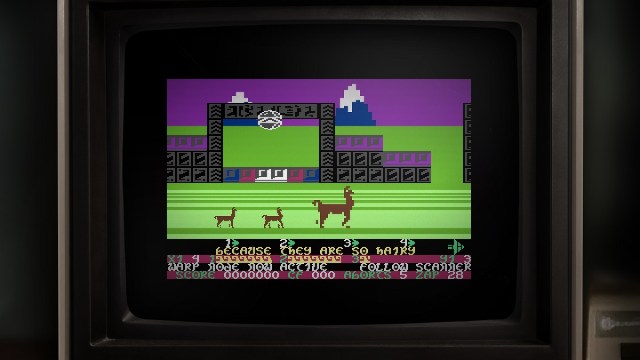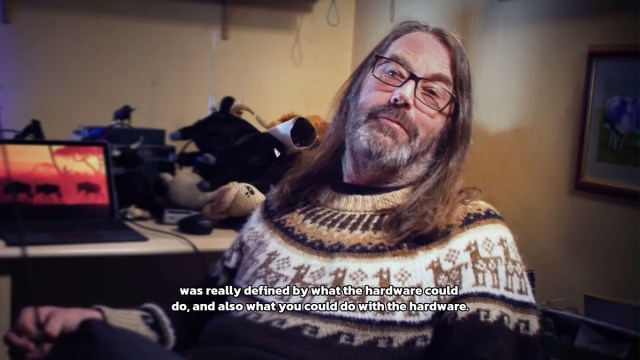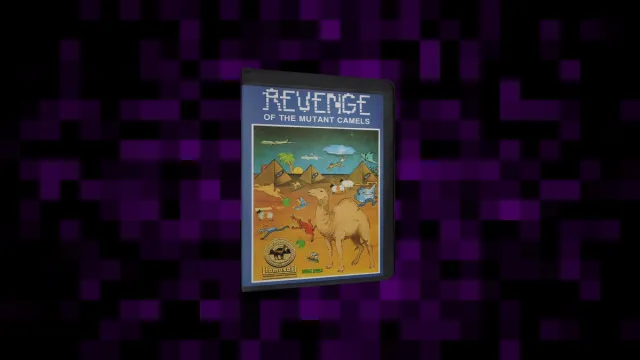As a North American, and someone who was too young to experience the ‘80s, I missed out on the home microcomputer era of video games. The era of the Commodore 64, Atari 8-bit, Apple II, and, of course, Jeff Minter.
I recently got a Commodore 64 of my own and have slowly been exploring the platform, but in the mass of floppy disks that came with it, I don’t believe there’s any early Minter. Therefore, my experience with his work has been secluded to more recent games like Tempest 2000 and Space Giraffe.
So, I was excited that Digital Eclipse’s next Gold Master game was going to be Llamasoft: The Jeff Minter Story, because my knowledge of the subject matter was superficial. And there’s nothing I love more than digging into video game history that I know little about.

Llamasoft: The Jeff Minter Story (PC [reviewed], PS4, PS5, Xbox One, Xbox SeriesX|S, Switch)
Developer: Digital Eclipse
Publisher: Digital Eclipse
Released: March 13, 2024
MSRP: $29.99
If you’re unfamiliar with Jeff Minter, I already named his most famous work, the Atari Jaguar’s 1994 title, Tempest 2000. It’s often cited as the doomed console’s best game and, by some, the only reason to really even own one. However, Minter’s been around for almost as long as the industry itself.
Llamasoft: The Jeff Minter Story starts off with the developer’s humble beginnings. It covers where he grew up, went to school, how he honed his programming skills during recovery from a medical emergency, and his subsequent dropping out of school. Then, we see the first game he ever programmed. Then the next one. Then the next one. And so on.
The previous Gold Master, The Making of Karateka was a deep dive into a single game. It explored Jordan Mechner’s career in the context of this game, revealing how it came to be. However, Jeff Minter didn’t have a big game. He had a long series of modest games. As such, Llamasoft: The Jeff Minter Story is focused on a much broader topic, and, as such, the pacing suffers.
If you are unfamiliar with the Gold Master Series, it currently consists of only two, but technically three, games. The format started with Atari 50: The Anniversary Collection and continued with The Making of Karateka. These are essentially game compilations, but rather than just throw a series of related games together like, say, Capcom Arcade Stadium, they provide a wealth of background information on their subject matter.
Llamasoft: The Jeff Minter story is important as a compilation because his works have never really been well archived. This is the first time that most of these games have been available outside their original platform. There’s 42 platformers here, including ports from various platforms. It’s not complete (a notable omission is Defender 2000, to which neither Atari nor Minter owns the rights), but it’s a massive improvement over the previous lack of preservation.
The problem is, most of these games were created by one guy programming out of his parent’s house. In terms of a documentary, Llamasoft: The Jeff Minter Story gets mired in the ‘80s. A lot of games just have the packaging and a quote written by Minter, which doesn’t really give a whole lot of context. Some of the best information is found in Llamasoft Newsletters, which are gigantic walls of text. Minter’s ramblings are one of the most enjoyable parts of the collection, but they don’t lend well to pacing.
By the time you escape the game’s second chapter, it feels as though you’ve just been released from a stupor filled with visions of barnyard creatures.

Many of the games themselves are quick arcade titles. Minter began his career by essentially cloning arcade titles for home computers – which, as the collection points out is what a lot of early programmers did to get started – and they don’t get a whole lot more complex. For the time, this was the bread and butter of the home computer market, as more ambitious games like Elite and Ultima were quite rare to see.
What makes Minter both interesting and famous is the evolution of his style. From arcade knock-offs, he begins incorporating weird animals before going off the deep end with some very trippy effects. It’s neat to see unfold. Just slowly. Very slowly.
Having interviews to watch feels like a relief, even when they just consist of Jeff Minter reclining in his chair, reminiscing about the past. Things like cover art and instruction manuals are great inclusions, but they really pad the time between interesting parts.
I understand that this is a look at someone’s career and that most people’s lives aren’t built like three-act plays. Furthermore, I really appreciate having all this stuff to look over. However, I think more focus should have been put on the really interesting parts. Moments where Minter argues with the era’s game critics and the decline of the indie and microcomputer markets stand out. I’d love to hear more about the demise of the Konix, but there isn’t a single video interview at the time. I’d love to hear Minter talk about getting screwed out of £5000 for a Konix development kit, but that’s completely missing.

The result is that while Llamasoft: The Jeff Minter Story still contains a lot of fascinating material and great games, it’s not a very good read. I think one of the successes of The Making of Karateka is the way that they had Jordan Mechner on screen with his father for long periods of time, talking in depth about every aspect of the game.
Minter, and the people who are interviewed to talk about him, don’t really have deep insight most of the time. It feels very superficial, which was already where my knowledge of the subject was at. I don’t think I actually learned much. I played a bunch of games I hadn’t before, but where The Making of Karateka excelled was by giving a great deal of appreciable context. That’s not absent here, but it’s a lot less impactful.
The Making of Karateka feels like it was told by someone who really loves video games, whereas Llamasoft: The Jeff Minter Story feels more like it was told by someone who loves Jeff Minter. It’s more interested in showing the man and less about telling his story. Instead, Llamasoft: The Jeff Minter Story just feels like an organized box of stuff. It’s a pretty great box of stuff, but it should have been more than that.
[This review is based on a retail build of the game provided by the publisher.]






Published: Mar 12, 2024 11:01 pm